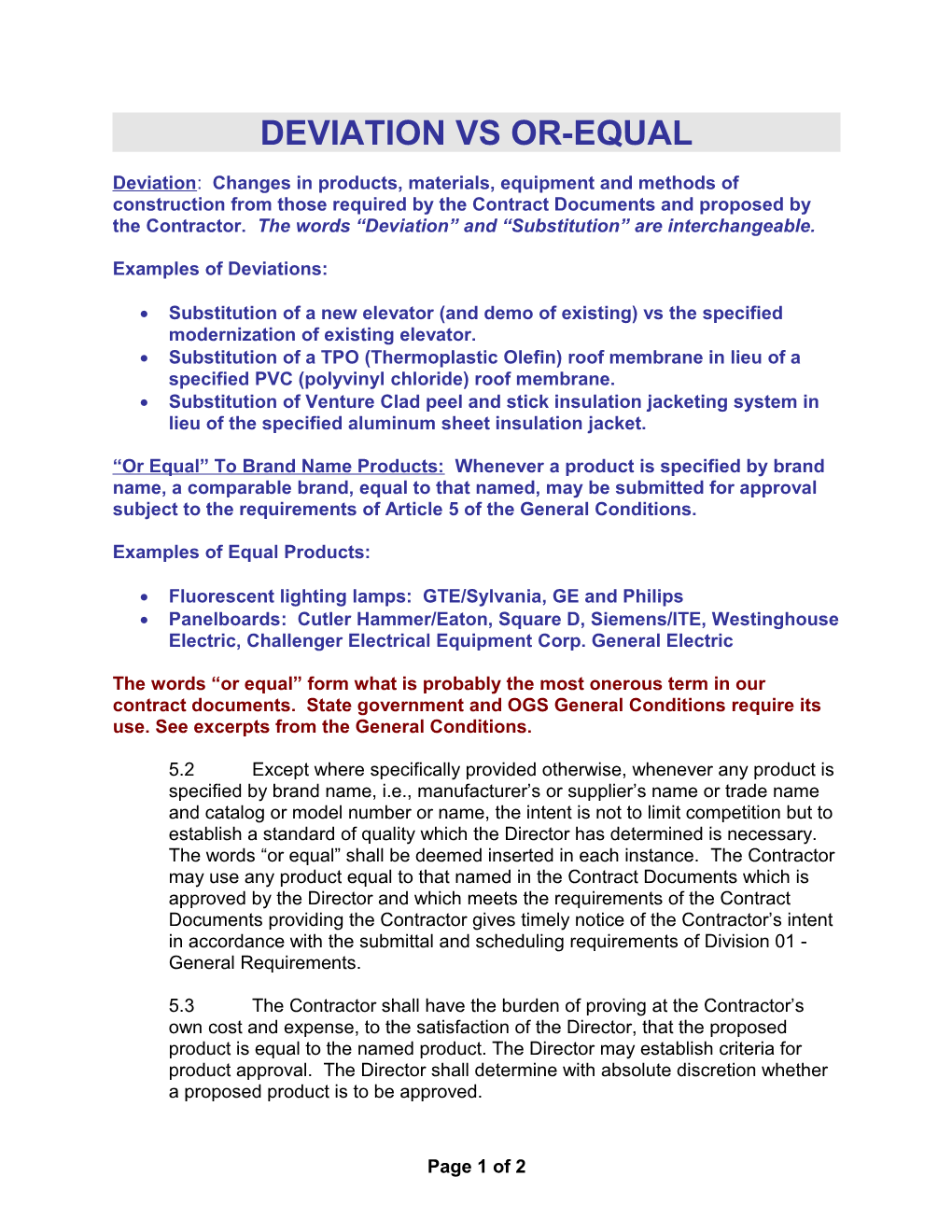DEVIATION VS OR-EQUAL
Deviation: Changes in products, materials, equipment and methods of construction from those required by the Contract Documents and proposed by the Contractor.The words “Deviation” and “Substitution” are interchangeable.
Examples of Deviations:
- Substitution of a new elevator (and demo of existing) vs the specified modernization of existing elevator.
- Substitution of a TPO (Thermoplastic Olefin) roof membrane in lieu of a specified PVC (polyvinyl chloride) roof membrane.
- Substitution of Venture Clad peel and stick insulation jacketing system in lieu of the specified aluminum sheet insulation jacket.
“Or Equal” To Brand Name Products: Whenever a product is specified by brand name, a comparable brand, equal to that named, may be submitted for approval subject to the requirements of Article 5 of the General Conditions.
Examples of Equal Products:
- Fluorescent lighting lamps: GTE/Sylvania, GE and Philips
- Panelboards: Cutler Hammer/Eaton, Square D, Siemens/ITE, Westinghouse Electric, Challenger Electrical Equipment Corp. General Electric
The words “or equal” form what is probably the most onerous term in our contract documents. State government and OGS General Conditions require its use. See excerpts from the General Conditions.
5.2 Except where specifically provided otherwise, whenever any product is specified by brand name, i.e., manufacturer’s or supplier’s name or trade name and catalog or model number or name, the intent is not to limit competition but to establish a standard of quality which the Director has determined is necessary. The words “or equal” shall be deemed inserted in each instance. The Contractor may use any product equal to that named in the Contract Documents which is approved by the Director and which meets the requirements of the Contract Documents providing the Contractor gives timely notice of the Contractor’s intent in accordance with the submittal and scheduling requirements of Division 01 - General Requirements.
5.3 The Contractor shall have the burden of proving at the Contractor’s own cost and expense, to the satisfaction of the Director, that the proposed product is equal to the named product. The Director may establish criteria for product approval. The Director shall determine with absolute discretion whether a proposed product is to be approved.
Some confusion is often apparent in specifications as to the difference between equivalents (“or equal”) and deviations. An “or equal” is a product that is equal to the standard of quality set in the contract documents. Its use should be an option of the bidder so as to allow for maximization of competition. Inherently the contractor takes a risk that his judgment of the product equivalence is proper since the design professional must approve the equivalent, post bid. The price advantage has already been gained by the State in the bid by the maximization of competition.
No two products are actually equal in every respect. Often, subtle differences between two products are the reason one product was selected over the other in the first place. The task of evaluating products is burdensome. Experience has shown that many contractor proposed “or equal” products are actually not only lower in cost but also in real value and quality.
A deviation (substitution), on the other hand, is a product of lesser or greater quality which does not meet the performance requirements of the specifications.
Most design professionals dislike dealing with deviations or substitutions because of the potential pitfalls and problems involved. Because selecting products is of vital importance of the success or failure of a project, design professionals spend considerable time evaluating them during the design phase; repeating the process with another product is not an enjoyable prospect.
Contractors typically request deviations if they offer an advantage to their firm, usually a financial gain or savings in time of construction. OGS (Design professionals or CRU) may not accurately establish the true value of a proposed deviation. Even when the bottom line is a reasonable cash credit to the client and all parties agree that the deviation is satisfactory,the true cost cannot be determined. Consideration of life-cycle cost,incompatibilities, energy, risk of delays, and many other important factors are often overlooked or poorly evaluated.
Page 1 of 2
